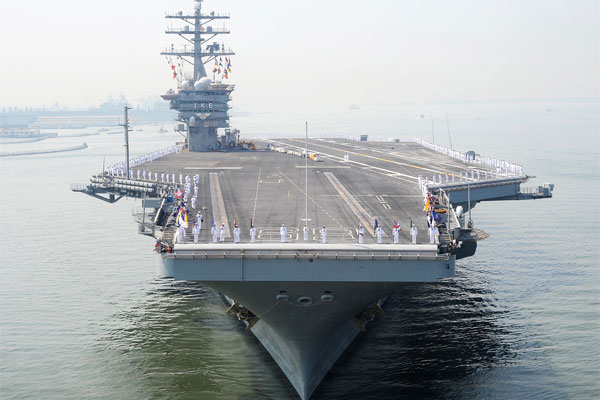My Navy vet sent me the follow up
- Navy: Human Error to Blame for Cable Break That Injured Eight Sailors
1.7K
54 comments
USS Eisenhower
The Virginian-Pilot | Jul 11, 2016 | by Courtney Mabeus
NORFOLK --
Navy investigators blamed human error and an improperly programmed valve for a March incident in which eight sailors were injured when a cable used to catch a landing
E-2C Hawkeye snapped on the flight deck of the
USS Dwight D. Eisenhower.
According to a Navy report obtained by The Virginian-Pilot through a Freedom of Information Act request, maintenance personnel missed at least one and possibly two "critical steps" while working on an engine that helps operate the carrier flight deck's cables, which are called cross deck pendants, after a previous landing.
As a result, the engine failed to slow the aircraft, instead causing the pendant to break "at or near" the Hawkeye's tailhook.
The Navy did not find evidence of willful dereliction of duty or negligence by the maintenance workers. The report said that while there was a "lack of procedural compliance" while troubleshooting an error code from a previous arrested landing, "the sailors involved reasonably believed they had properly and conscientiously completed the complicated procedure."
The Eisenhower Strike Group could not be reached for additional comment Friday. The strike group left
Naval Station Norfolk on June 1 for a seven-month deployment and on June 28 began flying combat sorties in support of Operation Inherent Resolve from the eastern Mediterranean Sea, the Navy has said.
Cross deck pendants are 1 1/2-inch-thick steel wires that stretch across a carrier flight deck and are used to catch a landing aircraft's tailhook. The four pendants that cross an aircraft carrier's flight deck are placed at 20-foot intervals and can be used for up to 125 landings, or "traps."
The other system of cables is attached to the steam engines underneath the flight deck; they are called purchase cables.
Those cables pull a movable part of the engine that travels along greased skids and pushes a giant piston into a cylinder full of pressurized hydraulic fluid. The piston compresses the fluid, bringing the wire on the flight deck, and the aircraft, to a stop.
In the March 18 incident, personnel that were troubleshooting a fault code from a previous arrested landing with the Eisenhower's No. 4 arresting gear engine were using an approved Navy procedure when they missed steps that led them to misprogram a valve that controls the gear engine's pressure and energy absorption, according to the report.
But that procedure lacked warnings, other notations and wasn't "user friendly," Navy investigators found. As a result, while those personnel failed to comply with a "technically correct written procedure," the Navy found their error understandable because the procedure didn't explain the basis for its steps, lacked supervisory controls and "failed to warn users of the critical nature" of the valve's realignment.
As the Hawkeye snagged the No. 4 wire, its three-person crew first sensed normal deceleration followed by a loud bang. They "heard the tailhook re-contact the flight deck, and felt a shudder," the report said. They realized "something had happened" when the Hawkeye continued toward the end of the flight deck.
Video of the incident released by the Navy on Friday shows a harrowing few moments in which the aircraft disappears off the flight deck and reappears several seconds later. Crew members aboard the flight deck can be seen running. Two sections of the broken No. 4 pendant and purchase cable "recoiled sharply and backlashed," the report says.
Eight sailors suffered a variety of injuries, including a fractured ankle, wrist, pelvis and legs. One sailor received skull and facial fractures while another suffered a possible
traumatic brain injury.
A
C-2A Greyhound and an
MH-60S Seahawk also received about $82,000 in damage, according to the report. At the time of the incident, the No. 4 cable had been trapped 16 times.
The report credits the "phenomenal airmanship" by the Hawkeye's crew. The plane landed safely at Norfolk Naval Station, where it is part of the Carrier Airborne Early Warning Squadron 123, or "Screwtops."
The Hawkeye is an early warning, turboprop aircraft used for command and control. It is recognizable by its 24-foot-diameter radar rotodome, a large disc attached to its upper fuselage.
A command investigation into the incident included recommendations for the development of additional controls for troubleshooting the carrier's aircraft recovery system as well as a review of the system's procedures to add necessary warnings, cautions and quality assurance.
It also included recommendations that Capt. Paul Spedero, commanding officer of the Ike, consider formal counseling, fitness evaluations, qualification removal, requalification or administrative actions for three others whose names were redacted.
___
This article was written by Courtney Mabeus from The Virginian-Pilot and was legally licensed through the NewsCred publisher network.
